Recently I've been trying to make a program that takes in a double in the form of a string. It then parses that to a double which goes to another class to be divided to a quarter or a half and then returns that output to a label.
I've been having an issue where when I click a button to actually submit what is inside the text field, the label doesn't change.
I've tried a lot of trial and error and I know I can change the text after doing new JLabel("test") for example. However, there seems to be an issue with my action listener for when the button is pushed. I can't tell if it's not seeing the button as being pushed.
NOTE: I am new to awt event things and swing as a whole, I usually operate just using the output terminal of visual studio code where it's just text and no graphics.
import javax.swing.*;
import java.awt.event.*;
import java.awt.Font;
import java.awt.Dimension;
public class MoneySorterRunner {
private MoneySorter sorter = new MoneySorter();
private String input = "0";
private double money = Double.parseDouble(input);
private static JTextField typeHere = new JTextField();
///labels num1-3 are the labels being changed
private static JLabel num1 = new JLabel(new MoneySorterRunner().sorter.divQuarter(new MoneySorterRunner().money));
private static JLabel num2 = new JLabel(new MoneySorterRunner().sorter.divQuarter(new MoneySorterRunner().money));
private static JLabel num3 = new JLabel(new MoneySorterRunner().sorter.divHalf(new MoneySorterRunner().money));
public static void main(String args[]) {
JFrame frame = new JFrame("Money Calculator - v0.1a");
JPanel panel = new JPanel();
JButton doThing = new JButton("Do a Thing");
doThing.setActionCommand("Do a Thing");
frame.add(panel);
frame.setDefaultCloseOperation(JFrame.EXIT_ON_CLOSE);
frame.setSize(500, 250);
frame.setLocation(200, 200);
frame.setResizable(false);
frame.setLocationRelativeTo(null);
panel.setLayout(null);
frame.setVisible(true);
JLabel item1 = new JLabel("test");
JLabel item2 = new JLabel("test");
JLabel item3 = new JLabel("test");
item1.setFont(new Font("Arial", Font.PLAIN, 30));
item2.setFont(new Font("Arial", Font.PLAIN, 30));
item3.setFont(new Font("Arial", Font.PLAIN, 30));
num1.setFont(new Font("Arial", Font.PLAIN, 25));
num2.setFont(new Font("Arial", Font.PLAIN, 25));
num3.setFont(new Font("Arial", Font.PLAIN, 25));
Dimension size1 = item1.getPreferredSize();
Dimension size2 = item2.getPreferredSize();
Dimension size3 = item3.getPreferredSize();
panel.add(item1);
panel.add(item2);
panel.add(item3);
panel.add(num1);
panel.add(num2);
panel.add(num3);
panel.add(doThing);
panel.add(typeHere);
item1.setBounds(10, 10, size1.width + 3, size1.height);
item2.setBounds(190, 10, size2.width + 3, size2.height);
item3.setBounds(325, 10, size3.width + 3, size3.height);
num1.setBounds(50, 50, 50, 25);
num2.setBounds(200, 50, 50, 25);
num3.setBounds(350, 50, 50, 25);
doThing.setBounds(250, 150, 100, 25);
typeHere.setBounds(100, 150, 150, 25);
}
public void actionPerformed(ActionEvent event){
String check = event.getActionCommand();
if(check.equals("Do a Thing")){
input = typeHere.getText();
}
if(input != "0"){
num1.setText(sorter.divQuarter(money));
num2.setText(sorter.divQuarter(money));
num3.setText(sorter.divHalf(money));
}
}
}
For those who wanted the MoneySorter.java:
public MoneySorter(){
}
public String divQuarter(double moneyIn){
String answer = Double.toString(moneyIn);
return answer;
}
public String divHalf(double moneyIn){
String answer = Double.toString(moneyIn);
return answer;
}
}


